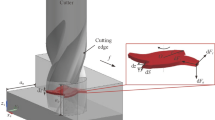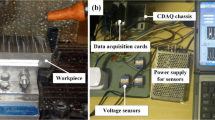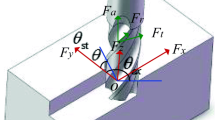Abstract
Tool wear is inevitable in actual manufacturing, especially in extreme processing conditions for machining difficult-to-cut materials. The monitoring of the tool state has an important influence on the surface quality and dimensional accuracy of the precision parts. In the previous studies, the original total power consumption is usually used to predict tool wear while ignoring the cutting power consumption accounts for a small proportion of the total power consumption of machine tools. Therefore, the accuracy is difficult to achieve the expected target. For better prediction results, a novel prediction method based on net cutting power consumption by Gaussian process regression (GPR) with ARD Matern 5/2 kernel is proposed in this study. Firstly, the physical model of net cutting power consumption is established. Then, tool wear under fixed working conditions is predicted by using the net cutting power consumption and GPR, and the advantage of the proposed method in this study is verified by comparing it with the existing methods. Finally, the proposed method is verified to obtain better prediction performance with variable cutting parameters than using total power consumption with the neural network. This study reveals that low-cost sensors like power meter can be used as an important supplement to monitoring tool conditions in the industry and also provides a research basis for predicting tool wear under different cutting conditions.












Similar content being viewed by others
Data availability
The authors confirm that the data supporting the findings of this study are available within the article.
References
Farhadi A, Gu L, Zhao WS, Rajurkar KP (2020) Tool path optimization based on wear prediction in Electric Arc Sweep Machining. J Manuf Process 54:328–336. https://doi.org/10.1016/j.jmapro.2020.03.011
Farahnakian M, Keshavarz ME, Elhami S, Razfar MR (2016) Effect of cutting edge modification on the tool flank wear in ultrasonically assisted turning of hardened steel. Proc Inst Mech Eng B J Eng Manuf 233(5):1472–1482. https://doi.org/10.1177/0954405416640416
Huang Y, Liang SY (2005) Modeling of cutting forces under hard turning conditions considering tool wear effect. J Manuf Sci Eng 127(2):262–270. https://doi.org/10.1115/1.1852571
Huang Y, Liang SY (2003) Cutting forces modeling considering the effect of tool thermal property—application to CBN hard turning. Int J Mach Tools Manuf 43(3):307–315. https://doi.org/10.1016/S0890-6955(02)00185-2
Huang Y, Liang SY (2004) Modeling of CBN tool flank wear progression in finish hard turning. J Manuf Sci Eng 126(1):98–106. https://doi.org/10.1115/1.1644543
Farahnakian M, Elhami S, Daneshpajooh H, Razfar MR (2017) Mechanistic modeling of cutting forces and tool flank wear in the thermally enhanced turning of hardened steel. Int J Adv Manuf Technol 88(9):2969–2983. https://doi.org/10.1007/s00170-016-9004-7
Li C, Li XL, Wu YQ, Zhang FH, Huang H (2019) Deformation mechanism and force modelling of the grinding of YAG single crystals. Int J Mach Tools Manuf 143:23–37. https://doi.org/10.1016/j.ijmachtools.2019.05.003
Li C, Piao YC, Meng BB, Hu YX, Li LQ, Zhang FH (2022) Phase transition and plastic deformation mechanisms induced by self-rotating grinding of GaN single crystals. Int J Mach Tools Manuf 172:103827. https://doi.org/10.1016/j.ijmachtools.2021.103827
Mohanraj T, Yerchuru J, Krishnan H, Nithin Aravind RS, Yameni R (2021) Development of tool condition monitoring system in end milling process using wavelet features and Hoelder’s exponent with machine learning algorithms. Measurement 173:108671. https://doi.org/10.1016/j.measurement.2020.108671
Zhu KP, Zhang Y (2019) A generic tool wear model and its application to force modeling and wear monitoring in high speed milling. Mech Syst Signal Process 115:147–161. https://doi.org/10.1016/j.ymssp.2018.05.045
Cooper C, Wang P, Zhang JJ, Gao RX, Roney T, Ragai I, Shaffer D (2020) Convolutional neural network-based tool condition monitoring in vertical milling operations using acoustic signals. Procedia Manuf 49:105–111. https://doi.org/10.1016/j.promfg.2020.07.004
Gomathi K, Balaji A (2021) Tool condition monitoring of PCB milling machine based on vibration analysis. Mater Today Proc 45:3386–3397. https://doi.org/10.1016/j.matpr.2020.12.778
Gokulachandran J, Bharath Krishna Reddy B (2021) A study on the usage of current signature for tool condition monitoring of drill bit. Mater Today Proc 46:4532–4536. https://doi.org/10.1016/j.matpr.2020.09.696
Goodall P, Pantazis D, West A (2020) A cyber physical system for tool condition monitoring using electrical power and a mechanistic model. Comput Ind 118:103223. https://doi.org/10.1016/j.compind.2020.103223
Sealy MP, Liu ZY, Zhang D, Guo YB, Liu ZQ (2016) Energy consumption and modeling in precision hard milling. J Clean Prod 135:1591–1601. https://doi.org/10.1016/j.jclepro.2015.10.094
Yoon HS, Lee JY, Kim MS, Ahn SH (2014) Empirical power-consumption model for material removal in three-axis milling. J Clean Prod 78:54–62. https://doi.org/10.1016/j.jclepro.2014.03.061
Shao H, Wang HL, Zhao XM (2004) A cutting power model for tool wear monitoring in milling. Int J Mach Tools Manuf 44(14):1503–1509. https://doi.org/10.1016/j.ijmachtools.2004.05.003
Liu ZY, Guo YB, Sealy MP, Liu ZQ (2016) Energy consumption and process sustainability of hard milling with tool wear progression. J Mater Process 229:305–312. https://doi.org/10.1016/j.jmatprotec.2015.09.032
Shi KN, Zhang DH, Liu N, Wang SB, Ren JX, Wang SL (2018) A novel energy consumption model for milling process considering tool wear progression. J Clean Prod 184:152–159. https://doi.org/10.1016/j.jclepro.2018.02.239
Corne R, Nath C, Mansori ME, Kurfess T (2017) Study of spindle power data with neural network for predicting real-time tool wear/breakage during inconel drilling. J Manuf Process 43:287–295. https://doi.org/10.1016/j.jmsy.2017.01.004
Drouillet C, Karandikar J, Nath C, Journeaux AC, Mansori EI, Kurfess T (2016) Tool life predictions in milling using spindle power with the neural network technique. J Manuf Process 22:161–168. https://doi.org/10.1016/j.jmapro.2016.03.010
Shen B, Gui YF, Chen B, Lin ZC, Liu Q, Liu QZ (2019) Application of spindle power signals in tool condition monitoring based on HHT algorithm. Int J Adv Manuf Technol 106(3–4):1385–1395. https://doi.org/10.1007/s00170-019-04684-0
Wang JJ, Li YL, Zhao R, Gao RX (2020) Physics guided neural network for machining tool wear prediction. J Manuf Syst 57:298–310. https://doi.org/10.1016/j.jmsy.2020.09.005
Phate M, Bendale A, Toney S, Phate V (2020) Prediction and optimization of tool wear rate during electric discharge machining of Al/Cu/Ni alloy using adaptive neuro-fuzzy inference system. Heliyon 6(10):e05308. https://doi.org/10.1016/j.heliyon.2020.e05308
Kong DD, Zhu JJ, Duan CQ, Lu LX, Chen DX (2020) Bayesian linear regression for surface roughness prediction. Mech Syst Signal Process 142:106770. https://doi.org/10.1016/j.ymssp.2020.106770
Kong DD, Chen YJ, Li N, Duan CQ, Lu LX, Chen DX (2019) Relevance vector machine for tool wear prediction. Mech Syst Signal Process 127:573–594. https://doi.org/10.1016/j.ymssp.2019.03.023
Kuntoğlu M, Sağlam H (2021) Investigation of signal behaviors for sensor fusion with tool condition monitoring system in turning. Measurement 173:108582. https://doi.org/10.1016/j.measurement.2020.108582
Bagga PJ, Makhesana MA, Patel HD, Patel KM (2021) Indirect method of tool wear measurement and prediction using ANN network in machining process. Mater Today Proc 44:1549–1554. https://doi.org/10.1016/j.matpr.2020.11.770
Zhou CA, Yang B, Guo K, Liu JW, Sun J, Song G, Zhu SW, Sun C, Jiang ZX (2020) Vibration singularity analysis for milling tool condition monitoring. J Mater Sci 166:105254. https://doi.org/10.1016/j.ijmecsci.2019.105254
Kong DD, Chen YJ, Li N (2018) Gaussian process regression for tool wear prediction. Mech Syst Signal Process 104:556–574. https://doi.org/10.1016/j.ymssp.2017.11.021
Pang XQ, Liu XY, Jia JF, Wen J, Shi YH, Zeng JC, Zhao Z (2021) A lithium-ion battery remaining useful life prediction method based on the incremental capacity analysis and Gaussian process regression. Microelectron Reliab 127:114405. https://doi.org/10.1016/j.microrel.2021.114405
Zhang CD, Wang W, Li H (2022) Tool wear prediction method based on symmetrized dot pattern and multi-covariance Gaussian process regression. Measurement 189:110466. https://doi.org/10.1016/j.measurement.2021.110466
Alagarsamy SV, Ravichandran M, Meignanamoorthy M, Sakthivelu S, Dineshkumar S (2020) Prediction of surface roughness and tool wear in milling process on brass (C26130) alloy by Taguchi technique. Mater Today Proc 21:189–193. https://doi.org/10.1016/j.matpr.2019.04.219
Xu DD, Liao ZR, Axinte D, Hardy M (2020) A novel method to continuously map the surface integrity and cutting mechanism transition in various cutting conditions. Int J Mach Tools Manuf 151:103529. https://doi.org/10.1016/j.ijmachtools.2020.103529
Shi KN, Ren JX, Wang SB, Liu N, Liu ZM, Zhang DH, Lu WF (2019) An improved cutting power-based model for evaluating total energy consumption in general end milling process. J Clean Prod 231:1330–1341. https://doi.org/10.1016/j.jclepro.2019.05.323
Liu N, Zhang YF, Lu WF (2015) A hybrid approach to energy consumption modelling based on cutting power: a milling case. J Clean Prod 104:264–272. https://doi.org/10.1016/j.jclepro.2015.05.049
Shi KN, Liu N, Liu CL, Ren JX, Yang SS, Tan WC (2022) Indirect approach for predicting cutting force coefficients and power consumption in milling process. Adv Manuf 1-13. https://doi.org/10.1007/s40436-021-00370-1
Nugraha RD, Chen S, Yin N, Wu TH, Zhang ZN (2021) Running-in real-time wear generation under vary working condition based on Gaussian process regression approximation. Measurement 181:109599. https://doi.org/10.1016/j.measurement.2021.109599
Roushangar K, Shahnazi S (2019) Prediction of sediment transport rates in gravel-bed rivers using Gaussian process regression. J Hydroinf 22(2):249–262. https://doi.org/10.2166/hydro.2019.077
Sheng HM, Liu X, Bai LB, Dong HC, Cheng YH (2021) Small sample state of health estimation based on weighted Gaussian process regression. J Energy Storage 41:102816. https://doi.org/10.1016/j.est.2021.102816
Funding
The authors would like to acknowledge the financial support provided by the National Natural Science Foundation of China (grant number 51905442), the National Major Science and Technology Projects of China (grant number J2019-VII-0001–0141), and the Aeronautical Science Foundation of China (grant number 2020Z045053001).
Author information
Authors and Affiliations
Contributions
All authors contributed to the study’s conception and design. Biyao Qiang conducted a Matlab software simulation and wrote the first draft of the manuscript. Kaining Shi proposed the conception of this work and performed the data analyses. Ning Liu contributed significantly to the analysis and manuscript preparation. Pan Zhao performed the machining experiment. Junxue Ren reviewed and edited the manuscript. All authors read and approved the final manuscript.
Corresponding authors
Ethics declarations
Ethics approval
Not applicable.
Consent to participate
Not applicable.
Consent for publication
The manuscript is approved by all the authors for publication.
Competing interests
The authors declare no competing interests.
Additional information
Publisher's note
Springer Nature remains neutral with regard to jurisdictional claims in published maps and institutional affiliations.
Rights and permissions
Springer Nature or its licensor (e.g. a society or other partner) holds exclusive rights to this article under a publishing agreement with the author(s) or other rightsholder(s); author self-archiving of the accepted manuscript version of this article is solely governed by the terms of such publishing agreement and applicable law.
About this article
Cite this article
Qiang, B., Shi, K., Liu, N. et al. Application of cutting power consumption in tool condition monitoring and wear prediction based on Gaussian process regression under variable cutting parameters. Int J Adv Manuf Technol 124, 37–50 (2023). https://doi.org/10.1007/s00170-022-10459-x
Received:
Accepted:
Published:
Issue Date:
DOI: https://doi.org/10.1007/s00170-022-10459-x




